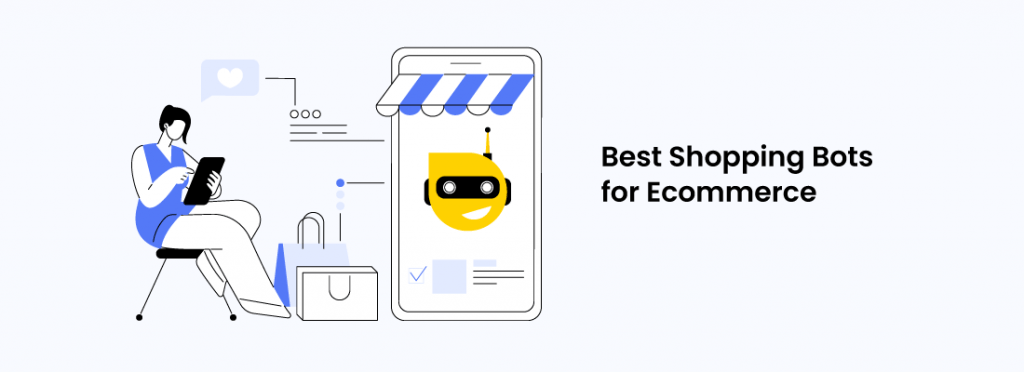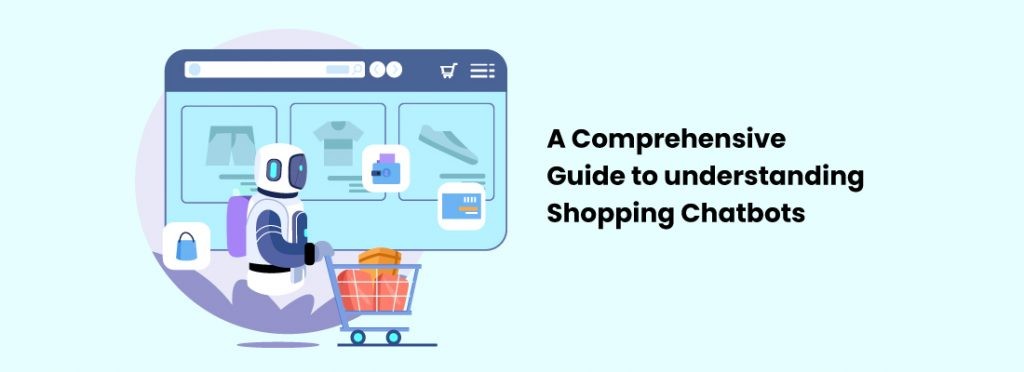Shopping chatbots are modern agents that use AI and NLP to interact with consumers and help them in their shopping experience.
These chatbots can assist customers in finding products, making purchases, and offering personalized recommendations based on their choices.
Shopping chatbots can be integrated into numerous channels, like websites, social media platforms, and messaging apps to provide a convenient and seamless shopping experience for customers.

What are shopping chatbots?
Shopping chatbots are computer programs designed to simulate interactions with human users for the purpose of helping them with their shopping needs.
These chatbots can assist customers in finding products, making purchases, tracking orders, and obtaining information about goods and services.
They can be integrated into e-commerce websites or messaging services like Facebook Messenger or WhatsApp.
Natural language processing (NLP) and machine learning are used by chatbots to comprehend the user’s inquiries and offer pertinent responses or recommendations.
Additionally, they can use feedback from prior contacts to enhance their suggestions and reactions.
Chatbots for shopping can be useful for both customers and businesses in a number of ways.
They can assist companies in automating customer service and sales, speeding up response times, and enhancing client satisfaction.
Customers can browse products and make purchases quickly and easily with the help of shopping chatbots, which can offer a convenient and personalized shopping experience.
How do shopping chatbots work?
Natural language processing (NLP) and machine learning techniques are frequently used by chatbots to comprehend the user’s purpose and answer appropriately.
Here’s a brief explanation of how they operate:
● User inputs:
A user communicates with the virtual assistant through a messaging interface, such as a website chat or a messaging platform.
The user might raise an issue, offer additional information, or seek support with a purchase.
● NLP processing:
The chatbot uses natural language processing to examine user input and determine the message’s intended meaning.
In order to do this, the user’s input must be divided into its component pieces, such as words and phrases, and those parts must then be mapped to certain actions or answers.
● Decision-making:
The chatbot chooses what to do next based on the user’s input and the outcomes of NLP processing.
For instance, it might suggest a product, offer more details, or request more information from the consumer.
● Response generation:
After deciding what to do, the chatbot creates a response and transmits it to the user.
Text, pictures, or links to pertinent items or web pages could all be included in the response.
● Machine learning:
As time passes, the chatbot gains knowledge from user interactions and enhances its performance in response to user input and data analysis.

Types of shopping chatbot
Chatbots for shopping come in a variety of forms, each of which is intended to carry out particular duties.
Some of the most typical varieties are listed below:
● Chatbots for product recommendations:
These chatbots suggest products to customers based on their tastes, past purchases, and browsing habits using data and machine learning algorithms.
● Chatbots for customer service:
These chatbots are made to manage customer questions, grievances, and problems while offering help and assistance in real time.
● Chatbots for order tracking:
These chatbots give customers real-time updates on the status of their orders, including information on shipment and delivery.
● Chatbots that act as shoppers’ assistants:
These chatbots guide customers around e-commerce sites, helping them find products and make purchases.
Also, they can make tailored recommendations and respond to inquiries about specific products.
● Chatbots for payment processing:
These chatbots manage security and payment processing for e-commerce transactions, protecting the privacy and confidentiality of user data.
● Chatbots for inventory management:
By delivering real-time updates on product availability and shipment timelines, these chatbots assist businesses in managing their inventory and stock levels.
● Chatbots for social media shopping:
These chatbots allow users to make purchases directly from Facebook and Instagram, allowing for a smooth shopping experience without having to leave the app.
Chatbots for shopping can help organizations in a variety of ways, from bettering consumer engagement and satisfaction to boosting sales and profitability.
Advantages of using shopping chatbots
For both businesses and customers, adopting shopping chatbots has a number of benefits.
The following are a few of the main advantages:
● 24/7 accessibility: Customers can get assistance and make purchases at any time of the day or night with the help of shopping chatbots, which can offer round-the-clock customer service and support.
● Shopping chatbots can utilize machine learning algorithms to assess client data and offer tailored product recommendations, increasing the likelihood that a sale will be made.
● Efficiency gains: Because chatbots can handle a variety of duties, like processing payments and making product recommendations, employees may concentrate on more difficult jobs, which increases productivity.
● Improved customer service: Shopping chatbots can provide a smooth and efficient shopping experience, enabling consumers to locate products and make purchases easily and quickly.
● Cost-effective: Shopping chatbots can decrease the requirement for human customer service agents, rescuing businesses’ money on labor costs.
● Scalability: These are perfect for firms that need to scale their operations quickly and effectively since they can handle a high volume of client questions and transactions.
Limitations and challenges of a shopping chatbot
Due to their capacity to deliver tailored shopping experiences, respond to client inquiries, and process transactions through conversational interfaces, shopping chatbots have grown in popularity in recent years.
However, there are a number of restrictions and difficulties related to shopping chatbots:
● Limited knowledge of natural language: Chatbots still find it difficult to understand natural language, which can result in misunderstandings of customer requests and confusion. The customer may become frustrated as a result, having a bad experience.
● Absence of context: It’s possible that shopping chatbots will occasionally lack the information necessary to comprehend a customer’s needs, preferences, and past interactions. This can make it extremely difficult for them to offer useful suggestions and personalised shopping perspectives.
● Inability to control complex queries: While chatbots can manage basic queries and exchanges, they may find it difficult with more complicated requests or questions. This can contribute to the customer being directed to a human operator, which defeats the point of having a chatbot in the first place.
● Security issues: Access to sensitive client data, such credit card numbers and personal information, may be needed for shopping chatbots. If these processes are not safe, they may be vulnerable to cyberattacks, putting client data at risk.
Final thoughts
In conclusion, shopping chatbots have the power to change the way consumers shop and engage with companies.
We can expect that as AI technology advances, shopping chatbots will become even more intelligent and play a bigger part in the retail sector.
To delve deep into this topic contact YugasBot.







